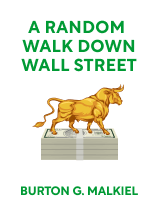

This article is an excerpt from the Shortform book guide to "A Random Walk Down Wall Street" by Burton G. Malkiel. Shortform has the world's best summaries and analyses of books you should be reading.
Like this article? Sign up for a free trial here .
What was the dot-com bubble? Why did this economic bubble burst?
The dot-com bubble was an economic bubble beginning in the late 1990s, caused by speculation and optimism about the rise of the internet. Although many “dot-com” companies had no earnings, shares prices were excessively high. Eventually, the “dot-com” bubble burst, with disastrous consequences for many companies.
Learn about the dot-com bubble below.
What Was the Dot-Com Bubble?
So, what was the dot-com bubble? In the financial world, the early 2000s were marked by the rise of Internet stocks. Even though many of these “dot-com” companies had zero earnings (and zero potential for realizing earnings), they were valued astronomically highly.
According to Nobel Prize–winning economist Robert Shiller, these stocks were valued so highly on account of “positive feedback loops.” Because the Internet was a new and exciting technology, any company associated with it attracted interest. This interest attracted investment, which attracted media coverage, which attracted more investment, which attracted more media coverage, and so on. However, positive feedback loops can only drive prices as long as there’s someone willing to pay the new high price for the stock. Once there are no more “greater fools” who believe the stock will continue to rise, the bottom falls out.
Of course, this is precisely what happened. In January of 2000, the price-earnings multiples of stocks in the NASDAQ Index—the index of technology and Internet stocks—were over 100, and investors expected returns of between 15 and 25 percent on Internet stocks. When the dot-com bubble burst later in the year, many Internet stocks became worthless, and blue-chip Internet stocks like Cisco and Amazon lost 86.5% and 98.7% of their value.
(Shortform note: From a high of $75.25 in 2000, Amazon fell to a low of $5.51 in 2001–2002. In May 2020, Amazon stock traded for $2,411.03.)
Example: The Enron Fraud
Perhaps no other company (another contender is WorldCom) so epitomizes the speculative mania of the early 2000s as the Enron fraud. Here’s an example of what went wrong during the dot-com bubble.
Enron bewitched investors and analysts with its cutting-edge approach to an old industry: energy. At the company’s height, observers believed Enron would not only dominate the energy space, but also lead in broadband internet and e-trading and e-commerce during the dot-com bubble.
Unfortunately for investors—and to the shame of professional analysts—Enron was obfuscating poor financial performance through an array of fraudulent activities. One noteworthy example concerns a joint venture Enron entered with Blockbuster (which, of course, went bankrupt itself in 2010). The venture failed, but Enron had already secured a loan from a Canadian bank for $115 million in exchange for future profits from the Blockbuster deal. Enron counted that $115 million as profit from the venture, and an accounting firm certified the company’s books as “fairly stating.” (Shortform note: Read our summary of The Smartest Guys in the Room.)

———End of Preview———
Like what you just read? Read the rest of the world's best book summary and analysis of Burton G. Malkiel's "A Random Walk Down Wall Street" at Shortform .
Here's what you'll find in our full A Random Walk Down Wall Street summary :
- A comprehensive and entertaining introduction to the world of finance
- Practical investment principles that work for every skill level
- The advantages of index investing






